Respecting the humanity and history of soil can help us grow a more resilient future for all.
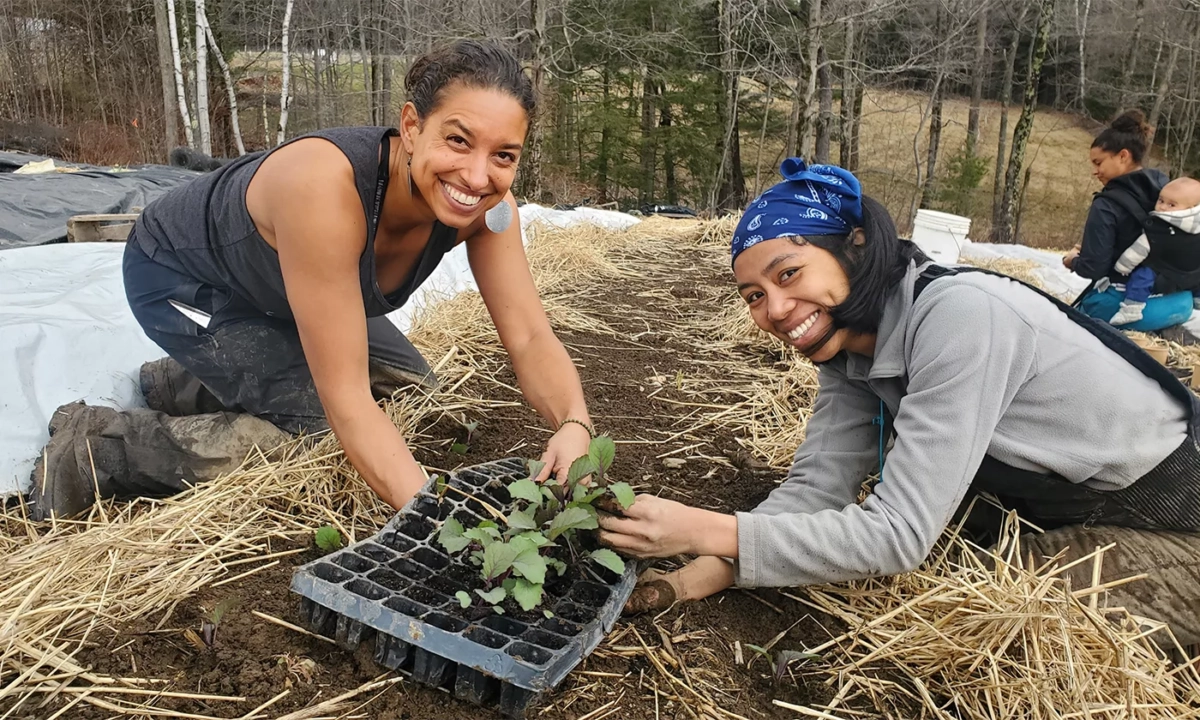
Aidee Guzman, 30, grew up the daughter of immigrants in California’s Central Valley, among massive fields of monocrops that epitomize intense, industrial agriculture. Her parents were farmworkers, and despite spending their days producing food, they relied on food banks to eat.
The cognitive dissonance of these circumstances hit home when, in 2003, at age 10, Guzman first visited her grandparents and family still living in her parents’ hometown in Mexico. Here, in the small community of El Pedregal de San Juan, in the state of Hidalgo, Guzman says she was amazed by the rain-fed milpa system of growing corn, wheat, and squash that her uncles still maintained, using seeds that have been in her family for generations.
“I was just so enamored,” she says. But anger and sadness followed as she came to understand the forces that caused her parents to migrate in search of employment in the United States. “People like my parents, they were pushed off the land.”
Guzman’s parents gave up caring for the soil and growing food that nourished them in pursuit of greater opportunities that involved growing crops for export and other people’s profit. It’s an ironic yet common occurrence: Although Western agriculture has begun embracing regenerative farming principles, the very people who have been using these practices since time immemorial have been socially, economically, and politically forced from the lands that sustain them.
“That’s not the society we should be living in,” says Guzman. Instead, she and a host of scientists, educators, farmers, organizers, and activists around the world are working to implement these regenerative principles and reciprocal practices, literally from the ground up.
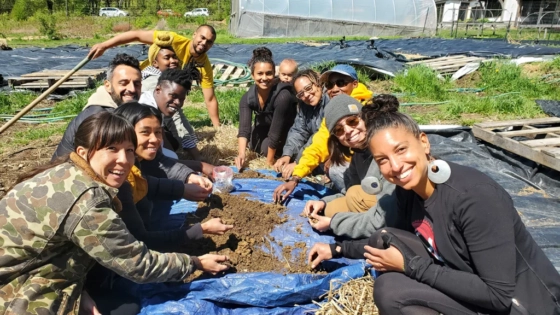
Soul Fire Farm’s team performing an earthworm count during a field soil-health test. (Photo courtesy of Soul Fire Farm)
Living history
“When I think about soil, I think about the ecosystem and I think about history,” says Briana Alfaro, administrative program manager at Soul Fire Farm in upstate New York. “I think about the geology that helped create the makeup of what minerals are in the soil.”
But soil is not just bits of rock and dust. In addition to minerals, it is composed of gas, water, living organisms, and the organic remains of once-living creatures. And the process of turning these components into soil is incredibly slow and microscopic. In the prairie, it takes between 100 and 1,000 years to develop one inch of topsoil. In alpine environments it can take even longer.
But destroying that formation, hundreds and thousands of years in the making, happens quickly. Humans can compact the soil in a matter of seconds with a bulldozer or a slab of concrete. During the Dust Bowl in the 1930s, due to massive disturbance of the soil through over-tilling, the center of the American continent lost 850 million tons of topsoil to the wind. And today, even when the soil stays on the ground, we’re actively destroying it through the use of pesticides, herbicides, synthetic fertilizers, and more.
Soil is alive. It is filled with life, and it supports the lives of so many living creatures—including us. Recognizing and tending to this reciprocal relationship could help shift our understanding of sustenance and what it takes to achieve lasting prosperity for both people and the planet.
Alfaro suggests using the term “soil livestock,” which she recently heard and feels best encapsulates the true work of caring for the soil. “It’s another part of farming, right?” Alfaro explains. “It’s another set of beings that you’re responsible for.”
How we respond to that responsibility will have compounding effects for the Earth—and all of us who live here. As the climate warms, and the human population grows, soil will be foundational to our thriving—or our downfall. At a core level, our collective survival will depend on how humans choose to interact with soil.
“The soil to me is the source of life. That is, it nurtures many of the lives—not just humans, but also the plants and animals and all those tiny things that we can’t even see,” says Miwa Aoki Takeuchi, associate professor in the University of Calgary’s department of education. “When we say ‘rich soil,’ we imagine the soil itself is populated with so many lives and diverse networks.”
And that richness can translate into the systems we use to impart value to other things in our lives and our economy.
“I think a healthy soil is a form of community wealth,” says Liz Carlisle, associate professor in the environmental studies program at University of California, Santa Barbara. “It’s an intergenerational form of community wealth.”
Carlisle studies the deep history of regenerative agriculture, going well beyond the buzzword it has become in environmental circles of late. She says it started with her grandmother, Helen, who had grown up on a farm in western Nebraska that the family eventually lost in the Dust Bowl. “As a child, I remember my grandmother saying, ‘You know, we need to learn how to take better care of the soil,’” recalls Carlisle. “It felt like a responsibility—having been born into this family that made some really big mistakes—to be part of a process of repair.”
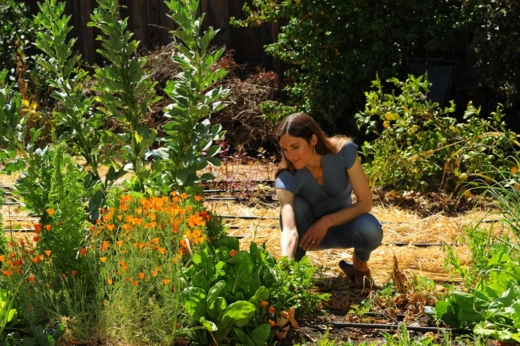
Liz Carlisle in her garden. (Photo by Su Evers)
Carlisle now focuses her research on Indigenous food systems that existed for thousands of years on the North American continent, on the African continent, on the Asian continent—all over the world. She contrasts these enduring practices with the hierarchical approach to industrial agriculture we see today: “Extracting from soil for short-term financial gain only makes sense in a world where certain people and other living beings fall outside of our circle of care. Whereas if we really believe that everybody’s life matters, it makes all kinds of sense to steward this common resource of soil for everyone and for those beings yet to come.”
Such a fundamental shift would upend how our society defines prosperity today.
When it comes to soils and what they’re producing, “we always seem to be using a cost-benefit analysis,” says Michael Kotutwa Johnson, assistant specialist at the University of Arizona’s Indigenous Resilience Center as well as its School of Natural Resources and the Environment. “Why can’t we look at a social-benefit analysis instead?”
In October 2023, Kotutwa Johnson hosted a group of scientists and educators from the National Autonomous University of Mexico, and he said the number one problem they wanted to address was not pollution or agricultural runoff—it was diabetes. He believes the spread of this disease is a direct result of the U.S. exporting its ideas of food and food policy.
“We need to rethink our policies, our agricultural policies, in the United States to focus more on quality, not quantity and efficiency,” he says.
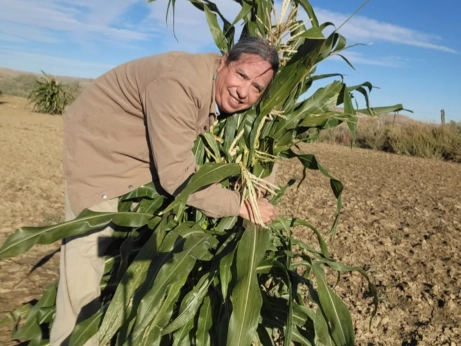
Michael Kotutwa Johnson hugging a corn plant. (Photo courtesy of Michael Kotutwa Johnson)
Kotutwa Johnson is a Hopi farmer who evaluates the success of his farming not only on the corn he produces but also on other impacts it has in his community: Are our bodies becoming healthier? Are these communities doing well?
For the Hopi, a matrilineal agricultural society, there is no distinction between their agricultural system, their belief system, and their social structures, Kotutwa Johnson explains. One cannot exist without the others, and they can only thrive together.
“The act of planting alone for us is an act of faith,” he says. “We live in a climate that only gives 6 to 10 inches of annual precipitation a year, but yet we’re able to raise things like corn, beans, melons, and squash, which I was told, when I went to Cornell, needed 33 inches of rain.”
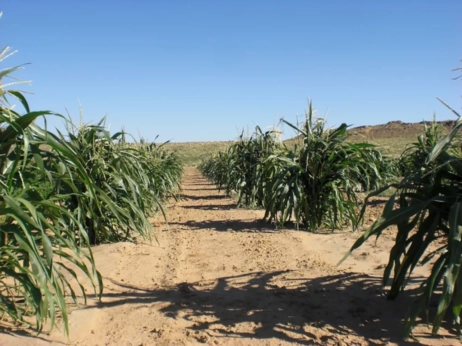
A field of Hopi corn, nonirrigated, grown with no herbicides, pesticides, or soil amenities such as nitrogen, phosphorus, or potassium. (Photo courtesy of Michael Kotutwa Johnson)
But creating a nurturing, respectful relationship with the soil and what grows from it has allowed these crops to thrive under Hopi stewardship.
“Those plants are like our people to us,” says Kotutwa Johnson. “We take care of those plants from when they’re little babies coming up out of the ground to when they get old and they pass on; and we lay them down at the end, and they provide us seeds for another generation.”
Laying down the cornstalks at the end of the plants’ lives, to Kotutwa Johnson, is a means of thanking them and giving them well-deserved rest. In Western terms, keeping the ground covered is a means of holding the soil in place to prevent erosion. As the organic ground cover breaks down, it also adds nutrients to the soil. So whatever the worldview behind it, this practice unquestionably leads to better soil health.
Reciprocity over extraction
Shifting from a relationship of extraction from soil to one of reciprocity with soil is central to Indigenous ways of knowing and growing—both food and community prosperity.
“Our ancestors revered soil and had such a relationship with it,” says Alfaro. “And that’s such a huge part of what we do at Soul Fire Farm: help bridge that connection, catalyze that connection for people—to land and to that ancestral knowledge.”
Central to this connection is an understanding that this type of relationship involves both give and take. For Alfaro, a multiracial Mexican American farmer and activist, this comes in many forms. “I feel better when I go spend time in my garden for so many reasons, you know, but I know that one of them is that I process and leave something behind every time I’m there.” She describes this process in natural terms, as the composting of sadness and grief. “I’m inevitably also growing myself food, growing my community food, growing my community flowers—all the things that help lighten me up and provide nutrition.” And the benefits of that relationship go both ways: “If we’re healthier, then we can give back to the soil more.”
Likewise, Aoki Takeuchi respects and finds inspiration in the way soil cooperates with others to decompose what humans consider garbage. “As someone who has experienced the intersectional system of oppression, I sometimes didn’t have a way to metabolize or decompose all the traumas,” she explains. But she uses soils as a literal and metaphorical lesson in her teaching. “How can [soils] metabolize that trauma, that historical trauma, and transform that into a source of nurturing and a source of growth?” says Aoki Takeuchi.
Her belief in the power of this work is part of what inspired Aoki Takeuchi to create Soil Camp, a program for refugee youth in Canada to rediscover and reconnect with land after they’ve been forcibly removed from their own. The goal of the summer research program is to “listen to the silenced voices of the soil, land, and displaced communities.”
And that reciprocity goes beyond the simple exchange of materials.
“How do we give back to the land for everything that the land has given us, including scientific and mathematical knowledge?” asks Kori Czuy, one of the instructors at Soil Camp and the manager of Indigenous science connections at the TELUS Spark Science Centre in Calgary. Western science always wants to name and categorize things definitively, but that’s not how Czuy teaches students. She de-emphasizes scientific hierarchies and rigid categorization.
“I always distinguish between the word[s] ‘knowing’ and ‘knowledge,’” Czuy says. “Knowledge is set. It’s the written word. It can’t be changed. It’s static. Knowing is alive.”
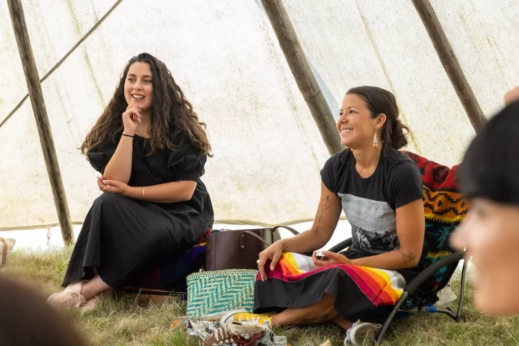
Soil Camp leaders sharing stories with children inside the tipi. (Photo courtesy of Fritz Tolentino/University of Calgary)
Land matters
But reconnecting with soil isn’t always possible, easy, or even desirable. Too many communities and people have been forced to work the soil on other people’s terms.
Carlisle says race is implicated in current U.S. food production in profound ways: “If you think about why we had a plantation system, and why we now have a system that still looks a lot like that, you could argue that it’s not because it’s the most productive way to produce food, but it is a very effective way to produce racial hierarchy.”
Carlisle says the pattern is painfully consistent around the world: “You have a global majority of people who carry traditions of regenerative food systems who are being excluded from land ownership, and yet who are being asked to labor in industrial agriculture, [who] are so infrequently in decision-making positions about how that land is cared for.”
“People have persisted and maintained these regenerative ways of relating to land in the face of hundreds of years of brutally oppressive structural violence,” she says. “It’s an instructive pathway of what it means to continually articulate a vision of reciprocal care—even in the face of the most tremendous obstacles.”
Carlisle says we can’t make meaningful strides toward regenerative agriculture if we don’t simultaneously insist on a transformative shift toward racial justice. “That’s work for all of us,” she says, “and I think it is especially work for those of us who identify as white.”
Guzman agrees that the transformation of our agricultural system needs to come from a place of inclusion and equity. “When we think of soil, and really trying to support soil and build up soil, we can’t forget … the human piece: that we need people who care about it to be able to have access.”
If that access were widely granted, Alfaro at Soul Fire Farms imagines a parallel shift in the way farmers relate to and invest in the soil. Without the limitations of one-year leases or the risk of displacement, she dreams of the beauty of transitioning away from annual crops that are planted and harvested every year, to perennial crops, which stay rooted in the ground more permanently, offering their benefits to the soil year-round and year after year. She says it was a profound moment when she learned “how beneficial it is to have perennials, to grow perennials, and what it means to be able to grow perennials, and what a privilege that is.”
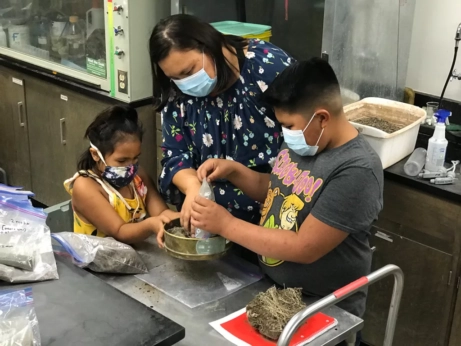
Latrice Tatsey sifting soils from her sample collections from the Blackfeet Buffalo Ranch, with her daughter Baeley and her son Terrance. (Photo courtesy of Latrice Tatsey)
The humanity of soil
As people, our bodies are deeply shaped by our environment and teem with microbial life in various forms of symbiosis. Maybe we’re not so different from soil after all.
“We’re all made of the same thing, you know, from rocks to microbes to everything,” Czuy says. “We’re all stardust. We’re all made of particles that are in motion constantly.”
Indigenous growers prioritize those personal connections and relationships with soil.
“It takes time to know your soil,” says Alfaro. “And there’s a lot of different ways you can get to know your soil. Start where you are: What is this soil? What does it like? What likes to grow here?”
In her soil camps, Aoki Takeuchi encourages students to connect with the soil in whatever way feels right for them.
“We really would like to foster a space for humbly listening, and listening in plural forms, so that we can listen to the very quiet voice of the soil.” She says that voice is easy to miss if we don’t pay attention—or if we limit our listening to ableist notions of the idea—but that there are many ways to listen to the story and honor the soil’s voice. “One could be seeing the color of the soil, another may be smelling different horizons of the soil.”
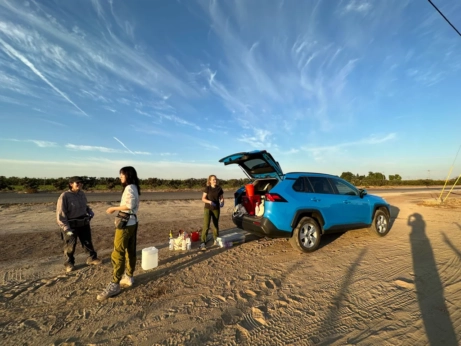
Aidee Guzman (left). (Photo courtesy of Aidee Guzman)
For Guzman, the connection to soil comes in the form of her passion for pottery, as well as her Ph.D. research with farmers much like her parents—who care deeply about the land but have been forced by economic circumstances to become cogs in the industrial food system. She holds fast to a reminder a professor once gave her: “‘When the revolution comes, we’re gonna need everyone—we’re also gonna need scientists.’”
Guzman says she considers herself a “cynical optimist.” “I’m kind of a shit-talker and hateful about where the system is … but really optimistic about the future.”
That optimism is important—because the stakes are only getting higher.
“In the face of the climate crisis, growing food has only become more and more difficult,” Carlisle says. “Farmers face flooding, droughts, extreme heat, new pest and disease challenges; and all of these are things that healthier soils can help farmers to weather.”
A soil with more organic matter is going to hold more water, which can prevent flooding in heavy rains and can help through long dry seasons and excessive heat. Healthier soils also make for healthier plants, which can better withstand pests and diseases. And those plants make for more dependable and nutritious food sources for people.
“It’s never been more important to steward this common resource of a healthy soil, as a matter of climate justice and food justice for those populations that will be most heavily impacted by the ways that these extreme weather events impact people’s ability to produce food,” Carlisle says.
Or, as Alfaro puts it: “There’s life in the soil, and we also have to take care of that so that we can be resilient.”
This story was originally published in YES! Magazine as part of ‘Redefining Prosperity,’ a four-part reported series exploring the ways that individuals, movements, and communities are shifting to a more holistic approach to prosperity.
Thank you to all those who preserve our land, food and health!!
Great read…Anyone who appreciates this article should read indigenous scientist/ botanist Robin Wall Kimmerer’s book Braiding Sweetgrass.